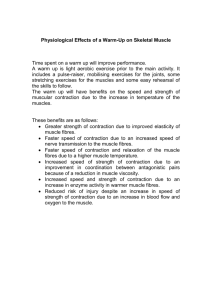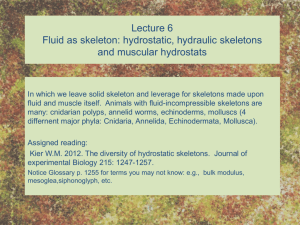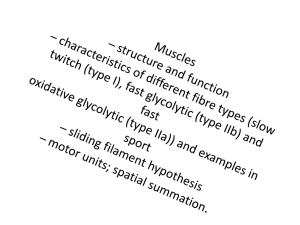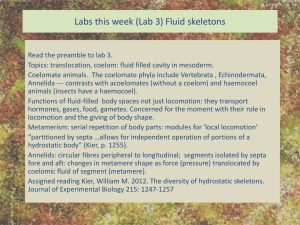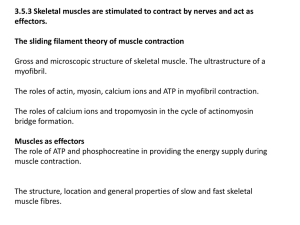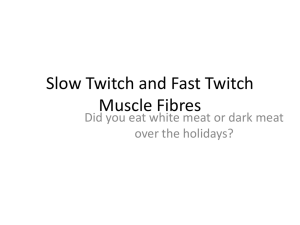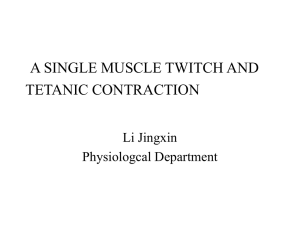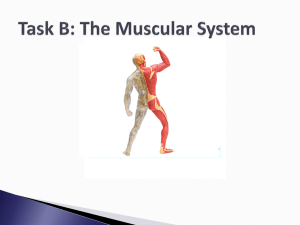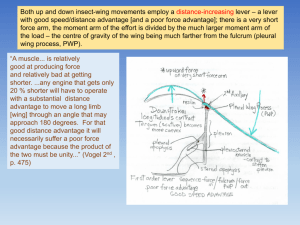hydrostatic skeleton
advertisement
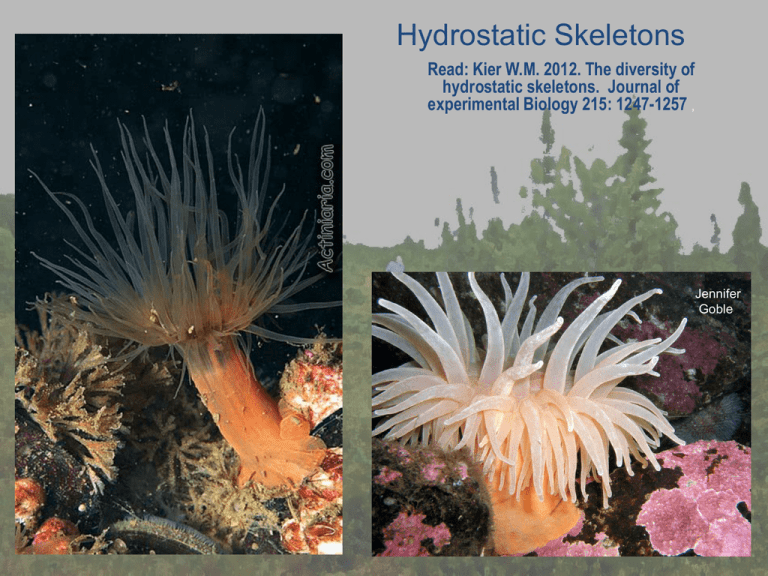
Hydrostatic Skeletons Read: Kier W.M. 2012. The diversity of hydrostatic skeletons. Journal of experimental Biology 215: 1247-1257 , Jennifer Goble Morphological diversity in treehoppers is conveyed by the helmet. B Prud’homme et al. Nature 473, 83-86 (2011) doi:10.1038/nature09977 • In the absence of a text it is very important to read and understand assigned papers, the first being Prud’homme 2011; this is assigned re membracids. For some papers of particular importance I will try to provide an essay online and I have done so for the membracid paper discussed last day. The essay tries to simplify the content a little, make it easier to follow and point out its importance. See the page on the 325 website called ‘Source paper essays’. What are you wearing to the tree? Genes retained as instructions for making the early stages of a prothoracic wing have formed the basis for making new adaptive structures. • This is an important paper because it gives insight into the process by which structures can evolve. As the authors say in their Abstract, it illustrates “how complex morphological structures can arise by the expression of ancestral developmental potentials”. Incorporating genetic instructions which once made a pair of wings on the prothoracic segment, these insects have evolved right and left appendages into a fused helmet that covers their body like a new ‘suit of clothes’; it has then been acted upon by selection in contexts such as crypsis, aposematism, or defensive spination -- to produce an astonishing diversity of species-specific structures. • Aposematic: an antipredator adaptation where a warning signal is associated with some noxious quality. Crypsis: ability of an organism to avoid observation or detection through camouflage Tetrigidae: pigmy locusts: could their odd pronota also be fused wings like those of membracids? Paratettix mexicanus photo by Robert Behrstock Arizona Saussurella sp. Malaysia Kurt (Hock Ping Guek) Our lab animal for many dissections Locusta migratoria The composite material of which insect exoskeletons are made: crystalline chitin nanofibres embedded in a protein matrix • • • • • Source: Vincent J.F.V. & Wegst U.G.K. 2004. Design and mechanical properties of insect cuticle. Arthropod Structure and Development 33: 187199. “The cuticle is ...multifunctional: it not only supports the insect, it gives it its shape, means of locomotion, waterproofing...” “The cuticle is secreted by a single layer of epidermal cells that covers the entire surface of the insect, extending into the tracheal system, fore- and hind-gut, and part of the genital system. ...it is composed of several layers (from the outside: cement and wax, then epicuticle, then exo- and endocuticle) most of the increase in understanding of its mechanical properties has been in the exo- and endocuticular layers, which make up the bulk of the thickness.” Insect cuticle is “a composite material (e.g., as is kevlar) consisting of arrangements of highly crystalline chitin nanofibres embedded in a matrix of protein, polyphenols and water, with small amounts of lipid.” The combined materials contribute differently to the mechanical properties. Chitin is a polysaccharide akin to cellulose D’arcy Thompson ‘diagram of forces’ Drawing on tests Please find on the website under ‘Lecture topics’ a newly posted explanation of the tentorium and its function from last Tuesday’s lecture, presented as an answer to a test question: it is a suggested way of organizing your studying toward the ‘standard’ 325 question: what is structure X and what is its function? Draw to learn shape. The Introduction of a paper is often the best place to find useful general information. Introduction from Kier 2012 • “Animal skeletons serve a variety of functions in support and movement. For example, the skeleton transmits the force generated by muscle contraction, providing support for maintenance of posture and for movement and locomotion. Also, because muscle as a tissue cannot actively elongate [muscles can’t push], skeletons provide for muscular antagonism, transmitting the force of contraction of a muscle or group of muscles to re-elongate their antagonists. In addition, the skeleton often serves to amplify the displacement, the velocity or the force of muscle contraction [mechanical amplification]. A wide range of animals and animal structures lack the rigid skeletal elements that characterize the skeletons of familiar animals such as the vertebrates and the arthropods. Instead these animals rely on a ‘hydrostatic skeleton’ ... in which the force of muscle contraction is transmitted by internal pressure” Kier 2012 is very clearly written. • Hydrostatic skeletons (see Kier Principles of support and movement) “typically include a volume of enclosed fluid. The fluid is usually a liquid (essentially water) and thus has a high bulk modulus, which simply means that it resists significant volume change.” It is effectively incompressible. • “Contraction of circular, radial or transverse muscle fibres will decrease the diameter, thereby increasing the pressure, and because no significant change in volume can occur, this decrease in diameter must result in an increase in length. The body of a sea anemone is “a hollow column that is closed at the base and equipped at the top with an oral disc that includes a ring of tentacles surrounding the mouth and pharynx” “By closing the mouth, the water in the internal cavity –the coelenteron – cannot escape and thus the internal [fluid] volume remains essentially constant. The walls of an anemone include a layer of circular muscle fibres. Longitudinal muscle fibres are found on the vertical partitions called septa that project radially inward into the coelenteron, including robust longitudinal retractor muscles along with sheets of parietal longitudinal muscle fibres adjacent to the body wall.” Fig. 5 Kier Phylum Cnidaria sea anemones, corals, jellyfish etc. “With the mouth closed, contraction of the circular muscle layer decreases the diameter and thereby increases the height of the anemone. Contraction of the longitudinal muscles shortens the anemone and re-extends the circular muscle fibres.” “...with this simple muscular arrangement a diverse array of bending movements and height change can be produced.” • Connective tissue fibre reinforcement • “The walls of many hydrostatic skeletons are reinforced with layers of connective tissue fibres that control and limit shape change. The fibres are typically arranged as a ‘crossed-fibre helical connective tissue array’ in which sheets of connective tissue fibres (often collagenous) wrap the body or structure in right- and left-handed helices. Even though the connective tissue fibres are typically stiff in tension and are thus relatively inextensible, such an arrangement actually allows length change. Elongation and shortening is possible because the pitch of the helix changes during elongation...” Phylum Annelida segmented worms species are mostly marine (polychaetes); Lumbricus is specialized for a terrestrial existence but is probably primitive in its fore and aft septa segmentation ABC News leech is also an annelid but more specialized Univ of Wisconsin the transverse grooving along its body does not represent its embryonic segmentation Transverse section Lumbricus Trochophore larva Annelida Trochophore larva of Annelida cronodon.com
